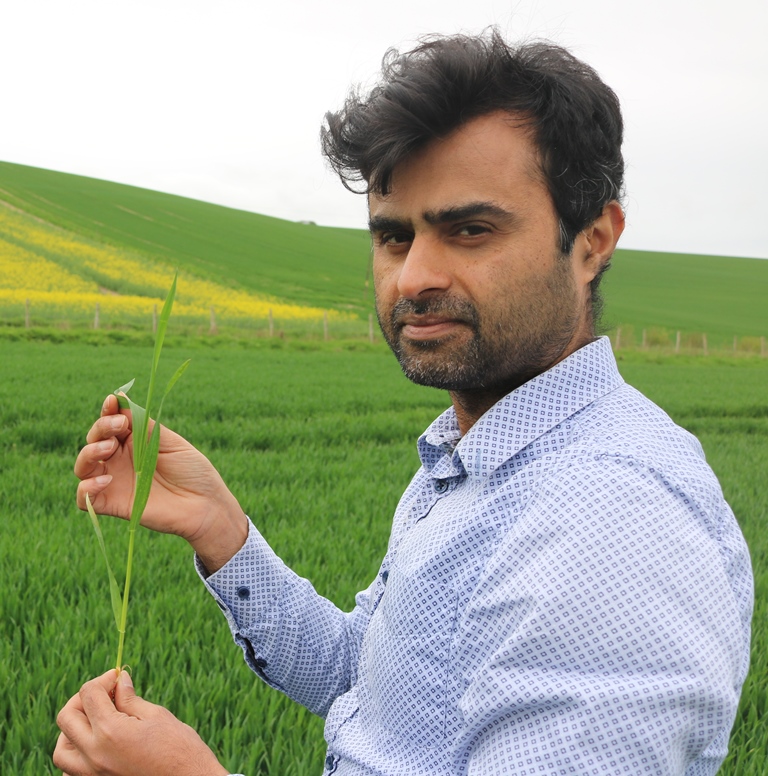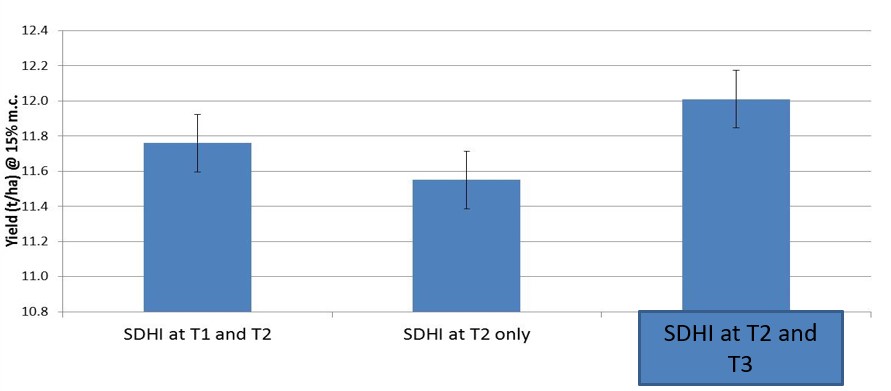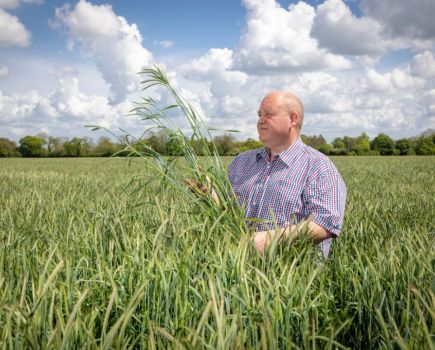Attending an open day or event at an iFarm this summer could bring far more than just an insight into some of the new concepts from Agrii’s extensive trials network. CPM finds out.
It’s a knowledge exchange – the important part is the dialogue.
By Tom Allen-Stevens and Rob Jones
Every year across 23 Agrii iFarms and five Technology Centres, around 5000 farmers will gather and talk about their crops. Although well thought of locally, the farms themselves aren’t the main interest – they host some demonstration plots, but even these aren’t where the true discoveries lie.
What’s transformational about the iFarms are the discussions themselves – groups of farmers taking concepts and ideas that have been replicated in trials and sharing thoughts on how these can be shaped to local conditions and adapted in their fields.
“The iFarms are a core part of putting our research into practice,” explains Agrii head of crop science David Langton. “But it’s a knowledge exchange – the important part is the dialogue.”
First set up in 2000, the network of sites, hosted by Agrii clients, are where agronomic innovations and new concepts can be demonstrated. This tends to be carried out on larger plots than replicated trials, with the emphasis being on visual, rather than statistical differences.
“For us, the real science takes place in our replicated trials – we need those for the resolution and accuracy of data we can have confidence in. But if all we did was rattle out charts of the results, farmers would just glaze over. The iFarms bring the science out into the field which is where the discussion takes place, with our customers and agronomists, and that turns the concepts into something that’s relevant locally.”
The concepts under test don’t originate just from the small-plot trials – Agrii works with machinery manufacturers, plant breeders and others to set up demonstrations to test new ideas. Open days will often bring in technical insight from independent agronomy groups, such as ADAS.
“The blackgrass demonstrations at Stow Longa are a good example of how the concept has evolved,” David explains. “It started out looking at the role of cultivations, but soon spread into rotations, seed rates, nutrition, variety, drilling date.
“Now we’re also looking at cover crops for blackgrass control as well as for overall soil health. But the really interesting change has been in the discussions that take place at Stow Longa – there’s hardly any talk of herbicides these days.”

Syed Shah suggests we can use SDHIs to extend green leaf area and shift their use to provide yield enhancement, rather than disease control.
And perhaps this is where disease control is heading. Dr Syed Shah leads research across the western Agrii sites looking at developing disease management strategies. “There are things we can do, and other factors that are beyond our control,” he explains.
“Variety selection is a good start, and then there’s much you can do to reduce disease pressure by drilling later or reducing the seed rate. Nutrition is important, and we know potassium plays a key role in improving disease tolerance. Manganese, copper and zinc also help by building strength into cell walls, and we’re just beginning to understand how biostimulants can improve a plant’s growth and resilience to disease.
“Fungicides should come last in that array of tools. We know that triazoles are losing their efficacy and there is the increasing risk of resistance to SDHIs – if we overuse them we will lose them.”
So Syed’s looking at the use of SDHIs in particular, and running trials to explore this. “Perhaps we can use SDHIs to extend green leaf area (GLA) and shift their use to provide yield enhancement, rather than disease control,” he suggests.
Every day of GLA at the end of the season brings an extra 0.15t/ha of yield, he notes, and growers often use strobilurins at T3, for example, to help this. “But if you managed your crop such that it didn’t need an SDHI at T1, you’d have the option of applying one at T3. Strobs might help retain GLA, but if late septoria comes in, they won’t control it.”
A trial in 2017 tested the concept. One SDHI applied at the T2 timing resulted in a yield reduction (although not statistically significant) from the standard two SDHI approach, applied at T1 and T2. But SDHIs at the two later timings gave a significant yield boost over a T2 SDHI alone (see chart below). Again this wasn’t significantly better than a T1 plus T2 SDHI, but indicates flexibility in timing of the second SDHI is possible, he says.
Effect of SDHI timing on yield

Source: Agrii, 2017. Average of two results at S Wales and Swindon. Cv RGT Illustrious, drilled 9 Oct.
“Of course 2017 was a very different season to this year, with minimal rain in April. This season, so far we’ve had higher spring rainfall than the last, very bad year for septoria – 2014,” notes Syed.
So unless you have a very resistant variety and are in a very low rainfall area, he’d recommend an SDHI at both T1 and T2 is likely to be the best approach. “The timing of your SDHIs should always reflect disease pressure and the season, and you could improve on this if you brought in other factors, such as variety and drilling date.
“The focus for fungicide use while the crop’s building its canopy should be on keeping a healthy plant protected, and there are many other ways to improve plant health.” Five trials across southern iFarms are currently underway to test the concept further.
Benchmark nutrients to improve in-season crop nutrition
A novel benchmarking approach to crop tissue testing has been developed following trials in winter wheat and oilseed rape at 23 iFarms across the country.
In a joint project with national specialists, Lancrop Laboratories, the work is giving growers and their agronomists far more precise information on the sufficiency of key macro- and micro-nutrients in their crops at different levels of performance throughout the season.
“Together we’ve up-rated leaf analysis from a tool primarily used to recover crop performance when something goes wrong to one that can be used to build performance by preventing things going wrong in the first place,” explains Agrii northern R&D manager, Jim Carswell who co-ordinated the project.
For the past 20 years, tissue-test reporting has been given against a fixed guideline using a traffic light system. “We’ve replaced this with one of graphical benchmarking by both performance level and growth stage.”
To secure the necessary data for this, the team organised fortnightly broad-spectrum nutrient analyses from 69 separate iFarm crops. Leaf samples of Zulu and Dickens wheats and DK Exalte winter OSR were taken at each site from early March through to mid-July last year.
All these crops – on different soil types and under different commercial farm regimes – were grown to best Agrii practice. All samples were taken from the youngest fully emerged leaf, growth stages were meticulously recorded, and crops were taken to yield.
The iFarm results were then married to data from thousands of crop samples analysed by Lancrop Laboratories over the past five years to develop season-long guideline models for the leaf content of 12 key macro and micro nutrients at both national average and high crop performance levels.
“Traditional tissue testing compares individual analyses with standard, mainly early season guidelines,” says Lancrop analytical services business manager, Simon Pogson. “But we wanted to provide better guidance for the increasing number of growers and agronomists using tissue testing at different crop growth stages to fine-tune their nutrient applications throughout the season. At the same time, we wanted to account for the increased nutrient demands of higher performance crops.
“Our work has enabled us to establish nutrient benchmarks at critical periods in the crops’ life that better reflect their needs at the time of sampling rather than just in the early season. And it has allowed us to do this by performance level as well as growth stage.”
Against five year national averages of 8.5t/ha for winter wheat and 3.6t/ha for OSR, the iFarm crops averaged 11.6t/ha and 5t/ha respectively. Plotting their analyses on individual nutrient graphs alongside the Lancrop national averages confirmed both the generally higher levels of key nutrients in the high performance crops and consistent trends in nutrient contents over the season.
As well as establishing a completely new set of nutritional indicators for both average and high performing wheats and OSRs, the team realised their work gave them the basis for a much more valuable way of tissue test reporting.
So, from this season they’ve developed an entirely new way of presenting results, with individual sample reports plotting the content of all 12 nutrients on separate graphs against both the UK average and the Agrii high performance standard.
“As well as having realistic targets for their crop nutrition throughout the season, this means our growers and agronomists can see at a glance exactly where their crop sits nutritionally compared with the average or our high performance standard at whatever growth stage the sample is taken,” says Jim Carswell.
Contour farming
iFarms across the country are employing the innovative digital agronomy service launched this spring to monitor their crops in more depth and with greater precision than ever. Visitors to this summer’s open days will be able to see the technology in action for themselves.
Using the most advanced cloud-penetrating radar and NDVI satellite imagery integrated with highly accurate local weather data and crop growth models, Contour has been developed by digital farming leaders, AgSpace to give growers and their agronomists a unique extra edge in their crop management.
“The new service allows us to see what’s going on in every part of every field every week,” explains Agrii agronomist, Greg Taylor who manages the Brackley iFarm with precision farming specialist, Sarah Hookway. “It gives us updated images of crop growth stage and variation across our fields whenever we need it on our tablets and smartphones.
“This means we can focus our field-walking attention on areas of possible concern for the most rapid and appropriate attention. And when we’re in the field we can log the locations of any issues we identify directly onto the system as valuable flags for our future management.”
Accurate green leaf area indexing and crop biomass predictions help with planning in-crop fertiliser applications, he adds. “Predicting the yield of winter wheat and barley from May with considerable accuracy is valuable too in allowing us to fine-tune late season inputs for the greatest cost benefit.
“A large number of my customers have already signed-up for Contour and love the immediate eye-in-the-sky access it gives them to their crops. They’re also finding its linkage to accurate local weather data – including soil temperatures – really useful in planning fieldwork on land at a distance.
The service can also be used to access the iFarm’s SoilQuest conductivity mapping to improve variable rate fertilisation, drilling and other key elements of the precision agronomy approach.
Extended summer open day programme
There’s an extended programme of more than 30 open days at Agrii Technology Centres and iFarms from Taunton in the south west to Culbokie in the north east this summer. These will provide growers with access to the latest information and advice from Agrii’s agronomy research and demonstration network.
Based around focused local and national trial work, each of these events will provide practical insights into the current performance of key varieties, nutrition, crop protection and other management programmes.
They will also feature displays and demonstrations from a range of exhibitors – including local Agrii mobile seed processing teams – and a special clinic run providing free testing of any moisture meters brought along on the day.
All those interested in joining-in should contact their local Agrii office for an invitation with full details of the event, location and timing.

Agri-science
Agrii’s extensive national trials programme is designed to help UK growers maximise their crop production opportunities in a fast-changing world, with the latest research-based technologies and approaches provided through experienced local agronomists.
Overseen by an ORETO-accredited (Official Recognition of Efficacy Testing facilities and Organisations) trials team, five regional Technology Centres, and a host of associated trials sites, explore and develop integrated agronomy-led solutions in more than 50,000 replicated trial plots each year.
A linked network of 23 ‘iFarms’ demonstrate these technologies and approaches in practice under commercial conditions while providing lively, interactive forums for agronomists and farmers to share experience and best practice.
With a multi-million pound investment from parent company, Origin Enterprises, Agrii’s farm-based weather station network, agronomy information portal and precision agronomy services are all being developed alongside this research and demonstration programme in a uniquely joined-up approach to meeting future arable, vegetable and fruit production challenges.




